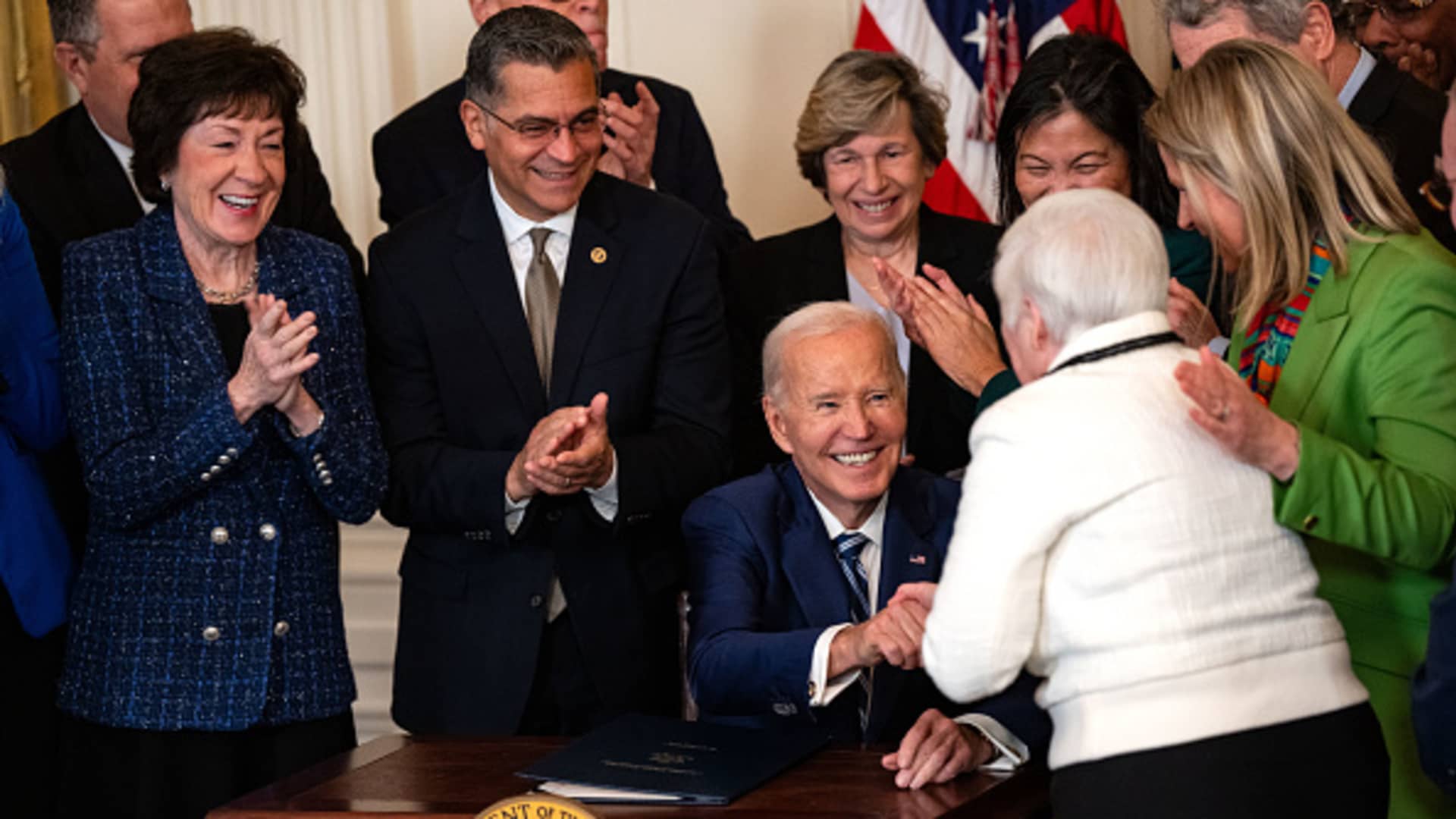President Joe Biden after he signed the Social Security Fairness Act at the White House on Jan. 5 in Washington, D.C.
Kent Nishimura | Getty Images News | Getty Images
The biggest changes to Social Security in years were signed into law on Jan. 5.
For more than 3.2 million individuals, that will mean bigger benefit checks. And in some cases, the change will qualify them for Social Security benefits.
The new law, the Social Security Fairness Act, repeals two provisions that previously reduced Social Security benefits for individuals who receive pension income based on work where employers were not required to withhold Social Security payroll taxes.
They were the Windfall Elimination Provision, which was enacted in 1983, and the Government Pension Offset, which was signed into law in 1977. They were federal laws that reduced Social Security benefits for people who received pensions from noncovered employment. Both were repealed by the Social Security Fairness Act.
Among those affected include certain teachers, firefighters and police officers, federal employees, and workers covered by a foreign social security system.
Benefit increases may range from “very little” to more than $1,000 per month, according to the Social Security Administration.
Those increases apply to future monthly checks, as well as retroactive benefits payable since January 2024.
The Social Security Administration “expects that it could take more than one year to adjust benefits and pay all retroactive benefits,” the agency says on its website.
Nevertheless, advocates who fought for the change for years — some of whom will see their own benefits increase — say the signing of the bill was a victory, even as many beneficiaries face an indefinite wait for the extra money.
‘It’s going to take some time,’ a former teacher said of the changes
Roger Boudreau, a 75-year-old former English teacher and president of the Rhode Island American Federation of Teachers retirees chapter, had been to the White House before through his work in union activism over the past 50 years.
But witnessing the signing of the Social Security Fairness Act in January was the “highlight of my life,” he said.
When Boudreau dies, he hopes his role as a founding member of the National WEP/GPO Repeal Task Force is included in his obituary.
“It was such an incredibly important piece of legislation that affected so many people who’ve been so deeply wronged for so many years,” Boudreau said. (To be sure, many retirement policy experts oppose the new policy.)
Boudreau estimates he personally has been losing about $5,000 per year in retirement due to a penalty of about 40% on his earned benefits for the past decade.
More from Personal Finance:
‘Keep your hands off our Social Security,’ lawmakers warn amid DOGE budget cuts
Here are changes Americans would make to close Social Security’s funding gap
Why retirees may feel the 2025 Social Security COLA isn’t enough
Boudreau taught for 30 years on a variety of subjects including world and British literature and earned a pension toward retirement.
To supplement his income, he took on a variety of extra jobs where he paid into Social Security, working as a taxi driver, selling swimming pools and helping at bakeries over the holidays.
“When I started teaching in 1971, my salary was $7,000 [a year],” Boudreau said. “I had an infant child. If I had two, I would have been eligible for food stamps.”
In addition to the extra work while teaching, he also paid into Social Security when he worked in high school and college. If Boudreau had two more years of earnings, he would have been able to escape the penalty to his benefits, he said.
Now, he’s waiting on the Social Security Administration to find out how large his benefit increases will be.
“We understand that it’s going to take some time,” said Boudreau, who also serves as a task force liaison to the American Federation of Teachers.
In the meantime, the group is advising its retirees to make appointments with their local Social Security office to make sure their information is up to date.
Firefighter hoped benefits would help in retirement
Carl Jordan, a retired Canton, Ohio, fire captain, first found out his Social Security benefits would be reduced when he looked into retiring.
The reductions were a surprise to Jordan, who over a 33-year career started as a firefighter and worked his way up to serve as a medic and finally a captain.
While he earned a pension from that work, he also paid into Social Security through other work. He started as a phlebotomist working in blood donation and then trained as a apheresis technician to collect blood products for the treatment of cancer and other diseases.
“The whole reason for me working the second job was it contributed to the community and it also aided me in taking care of my family at the time,” Jordan said.
“Firefighter wages weren’t that great, and I had hoped that Social Security would supplement my retirement income when I got there,” he said.
Today, Jordan, 73, estimates the reductions have cost him about 2½ years on his mortgage, or around $27,000 excluding interest.
The extra Social Security benefit money will help him pay off that mortgage a little sooner than expected, as well as pay for home improvements, he said.
Still, he doesn’t know exactly how much more benefits he will receive.
Jordan, who attended the January bill signing in Washington, D.C., spoke with a Social Security administrator there who said they could not provide more information on timing or the amount of benefit increases. A month later, he is still waiting for more information from the agency.
Nevertheless, Jordan said he was proud to witness a change he never expected to see in his lifetime, even after advocating for it for almost 16 years.
“To be there representing the profession that I had spent my life serving was an experience everyone should have,” Jordan said.
18-year-old lobbied on behalf of his grandmother
Eliseo Jimenez, who walked from Lubbock, Texas to Washington, DC, to discuss Social Security issues with government officials, leaves after being introduced by President Joe Biden during a signing ceremony for the Social Security Fairness Act at the White House.
Chris Kleponis | Afp | Getty Images
At 18 years old, Eliseo Jimenez of Lubbock, Texas, may be the youngest to have lobbied for the Social Security Fairness Act.
His grandmother, a former teacher, had to rely mostly on her own pension as her source of income before the new law. Other family members who work in law enforcement were also affected by the provisions.
To call attention to the need for change, Jimenez last summer spent 40 days walking from Texas to Washington, D.C. Because he was under 18 at the time, he was not able to check into hotels or motels on his own, which forced him to sleep outside for several nights.
His efforts helped bring attention to the issue, he said.
“I had a lot of people email me and call me, supporting me and supporting the bill itself,” Jimenez said.
Last month, Jimenez returned to Washington, D.C., again, this time to witness the signing of the Social Security Fairness Act. At the event, then President Joe Biden led a chorus of other lawmakers and attendees to sing “Happy Birthday” to Jimenez. It was “pretty cool,” he said.
Since the changes became law, he has heard from his grandmother, neighbors and residents from other states like Virginia and Tennessee who are affected.
“They said it’s like amazing,” Jimenez said. “It’s life-changing.”
The win has inspired Jimenez, a high school senior who plans to attend college next year, to keep pushing for Social Security reform. He plans to complete another walk in Texas next month to call attention to the issue.
“I want to keep on being involved,” Jimenez said. “I want to keep on advocating for it.”


 Personal Finance1 week ago
Personal Finance1 week ago
 Economics6 days ago
Economics6 days ago
 Economics1 week ago
Economics1 week ago
 Economics6 days ago
Economics6 days ago
 Finance6 days ago
Finance6 days ago
 Economics6 days ago
Economics6 days ago
 Economics4 days ago
Economics4 days ago
 Blog Post5 days ago
Blog Post5 days ago










